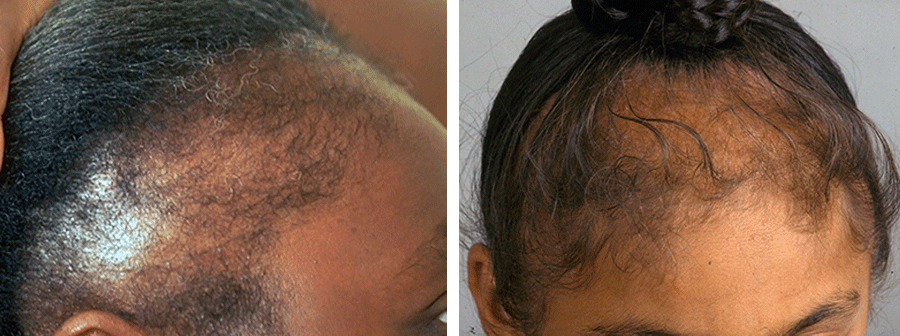Hairstyles that pull can lead to hair loss
A sleek ponytail, cornrows, tightly pulled updo, or head covering can help you express your style and look and feel great. However, these styles also constantly pull at and damage the health of your hair. Over time, the pulling can lead to hair loss.
The medical term for this type of hair loss is traction alopecia.

Anyone who wears tight hairstyles or puts repeated stress on their scalp can get traction alopecia. Some people experience traction alopecia more often than others because tight hairstyles are common in their culture or profession. This is especially true for girls and women of African descent.
Ballet dancers, military personnel, and anyone required to pull their hair back for work are also at a higher risk of getting traction alopecia.
Which hairstyles can lead to traction alopecia?
When the following hairstyles are too tight, they can cause traction alopecia:
Cornrows
Locs
Tightly braided hair
Buns, ponytails, and up-dos that are tightly pulled
Hair extensions or weaves, especially on relaxed hair
Styles that require rollers worn to bed most of the time
The constant rubbing of a hat, head scarf, or other hair covering over the hair can also lead to traction alopecia, especially if you pull your hair back tightly before covering it.
If you’re of African descent, the shape of your hair follicles makes your hair more likely to be damaged from rough or tight hairstyles.
Hair loss has many causes. You can find out more at Hair loss: Who gets and causes.
Children can get traction alopecia, too
Hairstyling habits that can lead to hair loss often begin at a young age.

How can I prevent hair loss caused by my hairstyle?
Dermatologists say that you can protect your hair while wearing your preferred hairstyles or garments by following these tips.
Avoid frequently wearing hairstyles that pull on your hair. Every once in a while, it’s okay to wear your hair tightly pulled back, but you want to avoid doing so often.
Loosen up your hairstyle so it doesn’t pull. To reduce the constant pulling, you can:
- Loosen braids, especially around your hairline.
- Opt for thicker braids and locs.
- Keep braids/locs short, because longer hair is heavier and pulls more.
- Wear braids for no longer than 6-8 weeks.
Follow precautions when wearing a weave. To prevent weaves from causing hair loss, dermatologists recommend that you:
- Wear them for short periods of time.
- Remove them immediately if they cause pain or irritate your scalp.
- Opt for sewn-in weaves rather than ones that use bonding glue.
- Make sure cornrows are not tight.
Switch up your hairstyle regularly so your hair can recover from tight styles. For example, after wearing cornrows, you may want to wear loose braids or go natural for a few months. When possible, give your hair a break from all styling to allow it to recover from stress. This can be done by adopting a natural hairstyle or by temporarily protecting your hair with wigs or scarfs.
Change your hairstyle immediately if you notice any of the following problems. These are signs that your hairstyle or products could cause hair loss:
- Pain from tightly pulled hair
- Stinging on your scalp
- Crusts on your scalp
- Tenting (sections of your scalp pulled up like a tent)
If you cover your hair, pull it back loosely beneath the covering. A head scarf or other covering made of silk or satin is gentler on hair than other materials.
Look for early signs of hair loss. If you wear hairstyles that pull tightly, take time every month to look for these early signs of hair loss:
- Broken hairs around your forehead
- A receding hairline
- Patches of hair loss where your hair is pulled tightly
Taking good care of your hair during your hair can help it look and feel good. You can learn more at Tips for healthy hair and Hair loss: Tips for managing.
Can traction alopecia be reversed?
The best way to halt hair loss is to partner with a board-certified dermatologist when you start noticing symptoms. That’s because some types of hair loss, including traction alopecia, can be permanent the longer they go untreated.
Your dermatologist can diagnose the type of hair loss you have and create a treatment plan that works for you.
If you’re diagnosed with traction alopecia, dermatologists say you should stop wearing tight hairstyles that cause stress to your hair follicle. Instead, your dermatologist can recommend low-risk alternatives, such as looser braids and reducing heat and products used on your hair.
Tip
If your hairstyle feels painful, the style is too tight.

If changing your hairstyling habits does not help, your dermatologist may prescribe a medicine to help regrow hair lost from traction alopecia, including:
Corticosteroids
Antibiotics
Minoxidil
For serious cases, your dermatologist may recommend a hair restoration procedure to increase the amount of hair in bald or thinning areas and, in some cases, restore your natural hairline. To learn more about these treatments, head to Hair loss: Diagnosis and treatment.
When should I see a dermatologist?
If you have hair loss, it’s never too early to see a board-certified dermatologist. People develop hair loss for many reasons. Your hairstyle may be the cause. It’s also possible that something else is causing your hair loss, such as stress or your genetics. A board-certified dermatologist knows how to get to the root of the problem. To find a dermatologist near you, go to Find a dermatologist.
Images
Image 1: Image used with permission of the American Academy of Dermatology National Library of Dermatologic Teaching Slides
Image 2: Reproduced with permission from ©DermNet www.dermnetnz.org 2024.
Images 3-4: Getty Images
References
Abdelwahab, M, Lam, Wilhelmina, et al. “A Literature Review and Guidance on Traction Alopecia in Hijab-Wearing Patients.” J Am Acad Dermatol. 2024; 91(3):AB8.
Afifi L, Oparaugo NC, Hogeling M. Review of traction alopecia in the pediatric patient: Diagnosis, prevention, and management. Pediatr Dermatol. 2021; 38: 42-48.
Asbeck S, Riley-Prescott C, Glaser E, Tosti A. Afro-Ethnic Hairstyling Trends, Risks, and Recommendations. Cosmetics. 2022; 9(1):17.
Billero, V, Miteva, M. (2018). “Traction alopecia: the root of the problem.” Clinical, Cosmetic and Investigational Dermatology. 2018;11. 149-159.
Written by:
Paula Ludmann, MS
Brooke Schleehauf
Reviewed by:
Neelam Khan, MD, MS, FAAD
William Warren Kwan, MD, FAAD
Temitayo Ogunleye, MD, FAAD
Last updated: 11/6/24
 Atopic dermatitis: More FDA-approved treatments
Atopic dermatitis: More FDA-approved treatments
 Biosimilars: 14 FAQs
Biosimilars: 14 FAQs
 How to trim your nails
How to trim your nails
 Relieve uncontrollably itchy skin
Relieve uncontrollably itchy skin
 Fade dark spots
Fade dark spots
 Untreatable razor bumps or acne?
Untreatable razor bumps or acne?
 Tattoo removal
Tattoo removal
 Scar treatment
Scar treatment
 Free materials to help raise skin cancer awareness
Free materials to help raise skin cancer awareness
 Dermatologist-approved lesson plans, activities you can use
Dermatologist-approved lesson plans, activities you can use
 Find a Dermatologist
Find a Dermatologist
 What is a dermatologist?
What is a dermatologist?